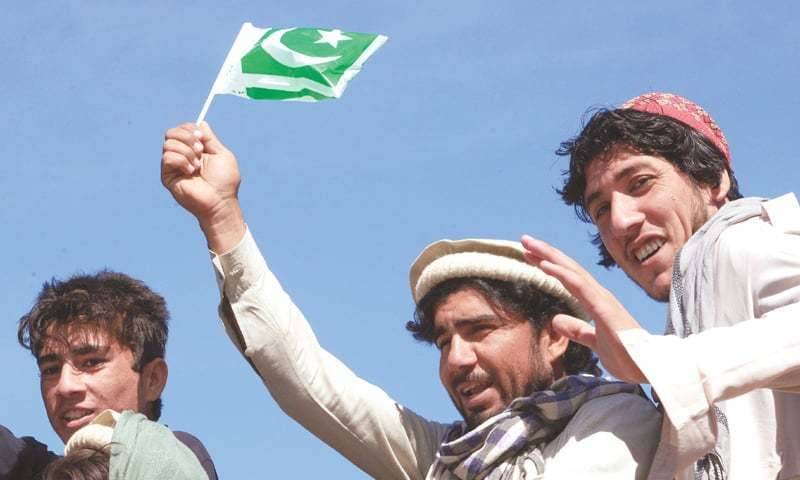
The Khyber Pakhtunkhwa (KP) government is making keen efforts to uplift the newly merged tribal districts and bring them at par with the rest of the province. The efforts will mainly focus on improving the infrastructure and ongoing development initiatives in the region.
The KP government has approved the Tribal Decade Strategy which would usher a new era of development in the merged tribal areas and speed up the integration process.
In the recent past, the tribal districts have faced the worst kind of law and order situation due to which the local people have suffered a lot, primarily in the form of large-scale displacements from their ancestral lands.
Per the new strategy, the provincial government has allocated Rs 59 billion for the temporarily displaced persons (TDP) for the financial year 2019-20. This allocation is three times more than the allocated budget for the development of other districts of the province.
According to KP government representatives, the total expenditure for the ten-year development campaign for tribal districts would be approximately one trillion rupees which would help the tribal districts in achieving healthy growth and stability.
According to KP Information Minister Shaukat Yusufzai, the provincial government is spending a huge amount of money for the uplift and development of the tribal districts which has never been seen in the past. The tribal territories, formerly known as the Federally Administered Tribal Areas (FATA), were among some of the most neglected areas of Pakistan for the last 72 years.
The minister also claimed that the law and order situation had been upgraded and local police stations had become operational in the region. He further said that the provincial government was making all-out efforts to utilise Pakistan-Afghanistan trade and transit route for the economic uplift of the said areas. “The KP government’s plan to make the border operational 24/7 is in the last stages of implementation,” he added.
In addition, the provincial government approved the construction of Neeli Tangi Weir sub-project in Khyber district along with the construction of Bada Khel Weir sub-project in an effort to solve the problem of energy crisis in the region.
It also merits mention here that the Peshawar High Court has extended its session courts to the tribal areas after the merger. Moreover, the district administration has started its operations in the merged districts as well.
According to some tribal people, the merger would prove beneficial for the region because now these areas had representation in the KP assembly. They also believed that the rate of development would spike due to the involvement of the provincial government in the entire process.
Meanwhile, the KP government also announced to construct hospitals, universities and other facilities in each district of the tribal region.
Despite the merger of the former tribal areas with KP, a section of the local population and some political parties are opposed to the idea of the merger and are instead voicing support for a separate province comprising of the tribal areas.
The KP government has approved the Tribal Decade Strategy which would usher a new era of development in the merged tribal areas and speed up the integration process.
In the recent past, the tribal districts have faced the worst kind of law and order situation due to which the local people have suffered a lot, primarily in the form of large-scale displacements from their ancestral lands.
Per the new strategy, the provincial government has allocated Rs 59 billion for the temporarily displaced persons (TDP) for the financial year 2019-20. This allocation is three times more than the allocated budget for the development of other districts of the province.
According to KP government representatives, the total expenditure for the ten-year development campaign for tribal districts would be approximately one trillion rupees which would help the tribal districts in achieving healthy growth and stability.
According to KP Information Minister Shaukat Yusufzai, the provincial government is spending a huge amount of money for the uplift and development of the tribal districts which has never been seen in the past. The tribal territories, formerly known as the Federally Administered Tribal Areas (FATA), were among some of the most neglected areas of Pakistan for the last 72 years.
The minister also claimed that the law and order situation had been upgraded and local police stations had become operational in the region. He further said that the provincial government was making all-out efforts to utilise Pakistan-Afghanistan trade and transit route for the economic uplift of the said areas. “The KP government’s plan to make the border operational 24/7 is in the last stages of implementation,” he added.
In addition, the provincial government approved the construction of Neeli Tangi Weir sub-project in Khyber district along with the construction of Bada Khel Weir sub-project in an effort to solve the problem of energy crisis in the region.
It also merits mention here that the Peshawar High Court has extended its session courts to the tribal areas after the merger. Moreover, the district administration has started its operations in the merged districts as well.
According to some tribal people, the merger would prove beneficial for the region because now these areas had representation in the KP assembly. They also believed that the rate of development would spike due to the involvement of the provincial government in the entire process.
Meanwhile, the KP government also announced to construct hospitals, universities and other facilities in each district of the tribal region.
Despite the merger of the former tribal areas with KP, a section of the local population and some political parties are opposed to the idea of the merger and are instead voicing support for a separate province comprising of the tribal areas.
